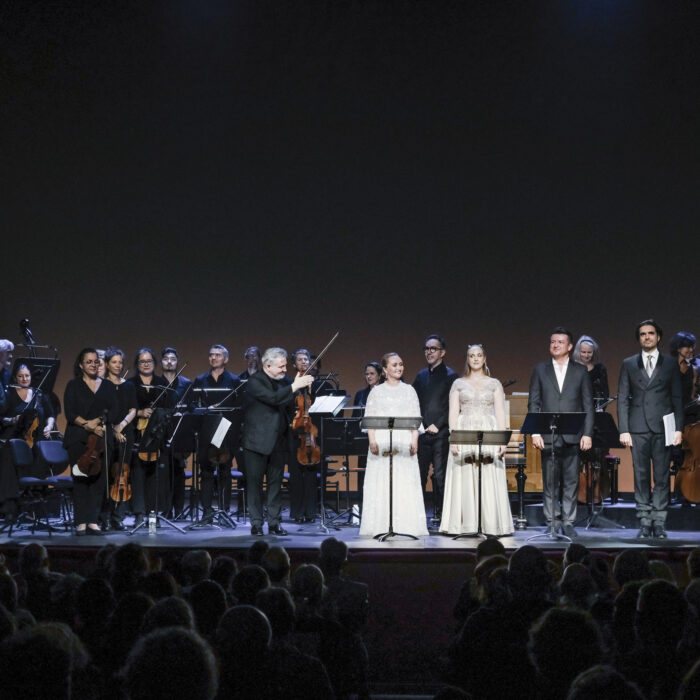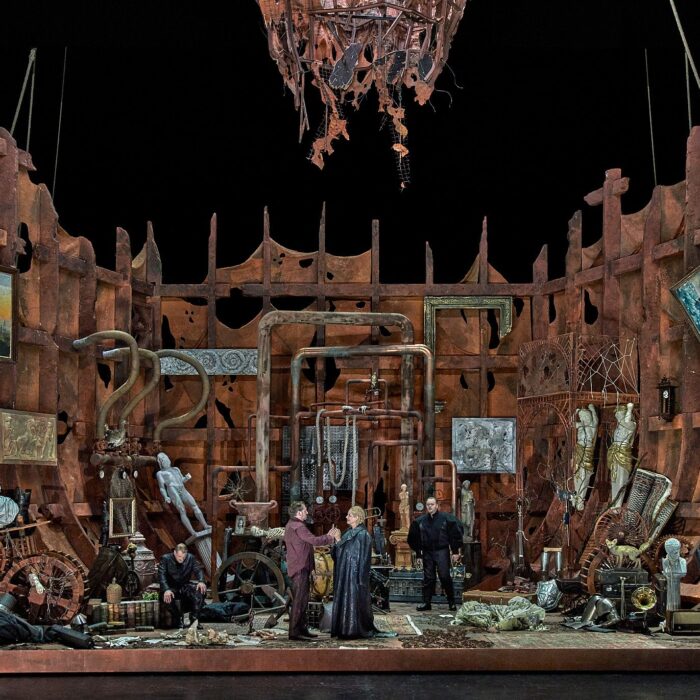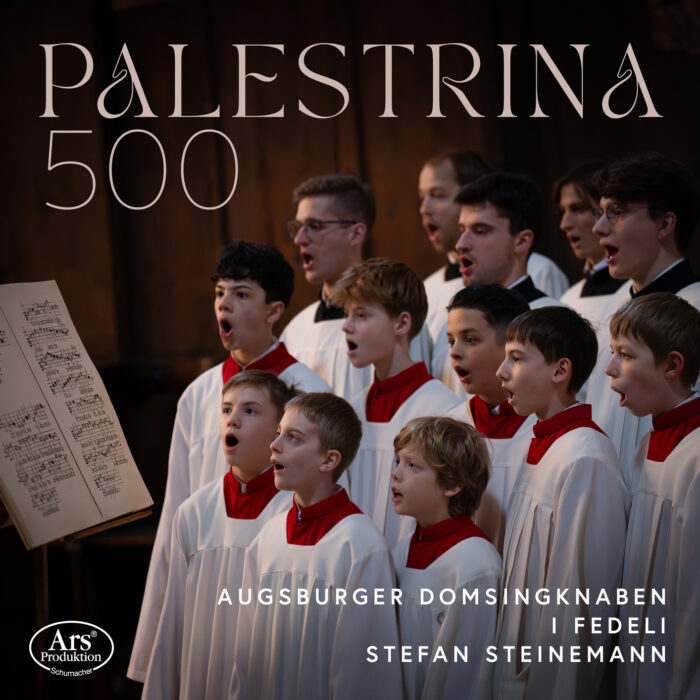
Macerata Opera Festival 2025 Review: Rigoletto
Macerata’s Authenticity Preserves Italian Culture With Production by the Arena Sferisterio Association & Director Federico Grazzini, Featuring Ruth Iniesta as Gilda in a Performance of a Lifetime
By Jennifer Pyron(Photo: MOF Simoncini)
The Macerata Opera Festival takes place at the outdoor Sferisterio Arena, constructed between 1823-1829, located next to the Porta Mercato gate and ancient walls of Macerata, Italy. The arena was originally built for the Italian national sport of pallone col bracciale which was popular for almost five centuries dating back to the 15th century. In 1921, the first season of the Macerata Opera Festival was presented. Since then electricity and proper stage design have been implemented and developed to present modern day productions of some of opera’s most beloved works. The arena holds approximately 2,400 people and the acoustics range from prime seats (located in the center), to the wing spans of the arena’s layout.

(Photo: MOF Simoncini)
Most of the time productions do not use amplification. However, in some cases it is necessary, especially during speaking moments. While most of the seating is ground level, there are two floors of box seats tucked neatly between rows of neoclassical columns that envelop the entire arena in a semi-circle. It is also a local secret that the best sight and sound experience takes place from the balcony (the top ledge of the arena’s wall above the box seats). This small area overlooks the city and center of the arena at the same time. Before the sun sets, one might even be able to see as far as the sea. These ‘seats’ are standing room only, but if one gets a chance to visit this viewpoint during an intermission it is absolutely well-worth it.
One of the most beautiful aspects of this arena is its proximity to the local restaurants, bars, and benches that line the main street (Piazza Giuseppe Mazzini). The majority of opera goers saunter through this area before the Sferisterio Arena gates open and it is an Italian summer experience in its prime. The local fashion is a major highlight, with notable handmade designs and colors to satiate anyone’s observational eye.
The Musei Civici di Palazzo Buonaccorsi is also very close to the Sferisterio Arena and a great idea to visit before getting dinner and then heading to the opera. The current exhibit on display in the museum’s main entrance hall (at the time of OperaWire’s visit this season) was a dedication to works by Renata Boero spanning from the mid 1970s to early 2000s. Her works, “Ctò-nio-grafie” and “Cromogrammi,” are canvases free from frame, enriched by natural pigments and organic processes, that depict the transitional period of an experimental artist from the late 20th century to the early 21st. The colors in her works mirror the warmth, beauty, and passion of Italy’s rich culture and naturally artistic aesthetic. Her work “Cromogramma Giallo” (1970-1975), portrays radiance like the setting sun that so often touches the walls and streets of Macerata, reminding one of life’s impermanence and the simple moments that mean everything in between. The museum also houses a very detailed and real life horse-drawn carriage exhibition in the basement that outlines the carriage’s evolution and development from the 18th to 20th century. It is a one-of-a-kind presentation.
The arena gates open at approximately 20:30 and the sun sets just before. Opera goers get drinks inside at the bar before they get seated and greet one another along the way. The stars come out shortly before the opera starts at 21:00 and shine brightly above, creating a canopy of untouched design and recalling to one the infinity of our universe and our smallness within its embrace. The Big Dipper constellation is a regular sighting during performances around the beginning of August and on this particular night there was a gathering of comets made visible when it was especially dark. The gentle breeze cools as the evening turns to night and it is advisable if one is wearing a sleeveless outfit to bring a light sweater or cape.

(Photo: MOF Simoncini)
There really is something uniquely special and remarkably authentic about this arena and Macerata itself. The locals take pride in their support for the opera season and applaud until the lights turn on at the end of each production. Opera is a local event that elevates the summers and the Macerata Opera Festival is where one can find it in its most tender regard. OperaWire’s coverage of this year’s festival season is in honor of this level of authenticity and awe.
Production Details
Giuseppe Verdi’s “Rigoletto” is one of the greatest and most powerful operas of all time. Its premiere took place on March 11, 1851 in La Fenice, Venice. The story of “Rigoletto” is centered around a court jester’s life among knights, ladies, pages, halberdiers, and the very well-known Duke of Mantua and Count of Monterone. His work, as a jester, challenges the motives and behaviors of men, especially the Duke of Mantua. However, Rigoletto’s life as a father to his own hidden daughter, Gilda, challenges him the most in return. After Rigoletto mocks the Count of Monterone, whose daughter was raped by the Duke, a curse is born.
The Duke of Mantua is hellbent on living out the theme of ‘boys will be boys’ (‘men will be men’). His court uplifts his radical and destructive ways of living in a conglomerate celebration of violent ideologies in order to save their own skins. The cowardice of their society feeds their madness and this quickly turns into a festering spiral when Rigoletto demands justice be had by the power of his own hand after his daughter is seduced by the Duke. Rigoletto deems it his life’s mission to expose the Duke to his daughter. However, his daughter’s heart has already been infected with the Duke’s lustful disease and she admits her blind love for him to Rigoletto. Thus, the curse rears its ugly head and Rigoletto’s efforts to renounce it proves to be his (and his daughter’s) own demise. This is only a short overview of the entire synopsis, but let it be the premise of the grave discovery that lies ahead, especially at the end of the opera.

(Photo: MOF Simoncini)
This production, by the Arena Sferisterio Association and Director Federico Grazzini in 2015, was inspired by Luna Park, an amusement park designed by Charles I.D. Looff that opened in Coney Island in 1903. Its name was inspired by a featured ride, ‘A Trip to the Moon,’ and the concept has been the blueprint of amusement parks across the world, especially in Europe, ever since. This past year, New York City celebrated a special exhibit in Luna Park’s honor, “Luna Luna.” This art installation by artist and curator André Heller opened in Hamburg, Germany in 1987, featuring over 30 renowned artists including Jean-Michel Basquiat, Salvador Dalí, and Sonia Delaunay. It also celebrated works by Keith Haring, David Hockney, Roy Lichtenstein, and Poncili Creación. I had the joy of attending “Luna Luna” this past year, and so, to see Luna Park come to life here at the Macerata Opera Festival really brought my experience full-circle and assisted me in understanding why “Rigoletto” fits in this space – a dreamy and nostalgic veil of ignorant bliss to mask reality.
The main portal in the center of the Sferisterio Arena’s stage was an exaggerated, open-mouthed clown face ready to swallow its visitors and hurl them out onto the other side. Its eyes bulged and its red veins distorted the white sclera of its crumbling eye sockets. There was a tattered strand of red lights glowing above this clown that read “Luna Park.” Yellow light strands extended from the center stage attached to poles on either side, illuminating the gang of men dressed in black suits and aggressively approaching. A woman’s screams rose above the orchestra playing the overture below. The audience watched as she scrambled in vain to be released from the men clawing at her, only to discover the gang swiftly delivering her to the Duke who then grabbed her by her hair on the back of her head and pushed her aggressively into the ticket booth on stage right. This was the opening scene of “Rigoletto,” when the Count of Monterone’s daughter was raped, witnessed, and mocked. The beginning of Rigoletto’s curse was born.

(Photo: MOF Simoncini)
Damiano Salerno as Rigoletto & Ruth Iniesta as Gilda Give Unforgettable Performances
Damiano Salerno as Rigoletto beamed with mocking enthusiasm at the sight of the Count of Monterone, celebrating the shame of him and his daughter. Salerno looked the part with his wild black hair and white painted face melting onto his white ruffled shirt neck and beaming red jacket. He was on a ‘jester’s mission’ to please the crowd of gathering men now surrounding him, anxiously awaiting him to tear down his next victim. The men mocked Rigoletto in return and Salerno’s pride visibly vanished when the Count cast his curse upon him, damning Rigoletto’s reaction and birthing the catalyst of his own end.
Salerno’s baritone fit the part of this complex Verdian role, but what stood out most was his adept interpretation of a damned and doomed father. Salerno’s major arias, ‘Pari siamo’ and ‘Cortigiani vil razza dannata,’ were delivered with vocal profundity. Most baritones lean towards being overtly wrapped up in the mockery of their portrayal, however Salerno rode the fine line of being a father first and a jester second in his performance. To see Rigoletto in this way was a notable experience. Instead of focusing on his vocal performance, which was solid, one learned most from his acting and interpretation of his role. The varied ways in which Salerno showed compassion towards his daughter mirrored his vocal production. Salerno’s interactions with the gang of men and the Duke also fell secondary to his tenderness for Gilda. He guided her through the opera in a protective manner, trying to shield her from the reality of a mad world. His intuitiveness in this way allowed Gilda to radiate and vocally triumph, which is exactly what made this night unforgettable.

(Photo: MOF Simoncini)
Ruth Iniesta as Gilda was the vocal highlight of this production in every way. Her soprano excelled while singing Verdi’s score and her special attention to ornamentation refined her performance emotionally. Iniesta’s Gilda had a very specific through-line that developed over the course of the opera and made her climactic ending that much more impactful. Her opening arias in Act Two, ‘Figlia Mio Padre!,’ ‘Deh! non parlare al misero,’ and ‘Gia de tre lune’ were sublime with her vocal agility and clarity unmatched. Her duets with the Duke, ‘Giovanna ho dei rimorsi,’ ‘Signor ne principe,’ ‘T’amo t’amo ripetilo,’ ‘Ah! inseparabile d’amore,’ and ‘E il sol dell’anima,’ were triumphs for the ages. Her soprano is reminiscent of Joan Sutherland in this role. Iniesta’s pure vocal quality is grounded in notable vocal technique that allowed her voice to flourish and expand into Sferisterio’s open air arena with ease and vitality.
Iniesta turned this opera’s point of focus inward and made Verdi’s score into something more than notated. Her voice interpreted Gilda’s innocence, heartache, courage, wisdom, and everlasting hope. Her most famous aria, ‘Caro nome che il mio cor,’ left audience members stunned. There was not a dry eye to be seen, everyone was in awe. Her final moments on stage, after she confronts the paid killer her father had hired to murder the Duke, were a testament to Iniesta’s philosophical interpretation of death and this production’s perspective on the afterlife. Instead of killing the Duke, Sparafucile (the hitman), stabs to death the first person he sees and when Gilda is at the front door she is faced with his knife’s blows. Sparafucile and his sister wrap Gilda’s body in a black body bag and set it aside for Rigoletto to dump in the river himself, as he requested to do with the Duke’s dead body. Upon reaching the edge of a soon to be flooded river area due to the raging storm taking place, Rigoletto unzips the bag and discovers his own daughter dying inside. This production then had a gentle spotlight turn on at stage left with Iniesta standing and watching on as Rigoletto loses his own mind over this discovery. To say this was unforgettable would be an understatement of massive disregard. This ending was legendary.
Salerno’s most famous aria, ‘Cortigiani vil razza dannata,’ at the end of this opera was another major highlight of the night. The soul crushing and insurmountable devastation his voice elicited was haunting. He gave life to Verdi’s composition in a way that felt grounded in reality while not over-the-top with emotion, which is difficult to do. Once again Salerno’s tenderness reminded one of how precious life is on and off the stage.

(Photo: MOF Simoncini)
More Cast Highlights
Ivan Magrì as the Duke of Mantua (and Gualtier Maldé) performed with a lot of effort to make his characters believable. His vocal performance in his first aria, ‘Questa o quella,’ revealed his vocal technique and unfortunately his inability to effectively project his voice over the orchestra and at times throughout the arena. His acting skills were overly emotional and volatile, making the Duke a villain seemingly without a target, except for any woman in sight. It was as though he was all over the place with his interpretations and this took away from his interactions with Gilda especially. There did not seem to be a real connection between the two and this might have left one wanting more altogether. Magrì’s performances of ‘Ella mi fu rapita,’ ‘Parmi veder le lagrima,’ ‘Duca Duca?,’ and ‘Possente amor mi chiama’ were entertaining and did garner him ample applause at the end of the night. However, the core of his performance felt aloof and detached from the tragedies of his very environment. Maybe this was what he was going for all along?
Bass-baritone Kwangsik Luca Park as Sparafucile was outstanding in his role. His voice rattled the audience to the bone. His duet with Rigoletto, ‘Quel vecchio maledivami… Signor va non ho niente,’ absolutely made a mark in this vocal lineup with his solid technique and resonance. Park portrayed Sparafucile as a working man who expects nothing from nobody and gets his work done no matter what it takes. There was a quality about his presence on stage that made Sparafucile more well-known than usual in this opera. Park has a great career ahead of him and it was exciting to see him perform at Macerata.
Carlotta Vichi as Maddalena (Sparafucile’s sister) flirted to her heart’s desire during her performance with the Duke. Her vocal technique and acting skills fit the part and made for an interesting turn of events when working closely with her brother the hitman, begging him to spare the Duke’s life and instead kill the first person he sees instead (unfortunately for Gilda). Vichi’s interactions with the Duke were also notably timid and aware of his aggressive behaviors towards women, making a strong case for women who can sense this level of warning even when words are difficult for them to speak out loud. “Rigoletto” and “Don Giovanni” are alike in a lot of ways, but there is something radically sinister at the core of “Rigoletto” that leaves zero space for redemption among the male characters. The animalistic rage of some and the ‘hero’s journey’ of others is all aligned with the reality that comes when the light of dawn falls upon them.

(Photo: MOF Simoncini)
Aleksandra Meteleva as Giovanna (Gilda’s guardian) was excellent in her role. Bass-baritone Alberto Comes as the Count of Monterone gave a strong performance and meaningful announcement of the curse that would take hold of Rigoletto. Giacomo Medici as Marullo (knight), Francesco Pittari as Matteo Borsa (courtier), Tong Liu as the Count of Ceprano, Aleksandra Meteleva as the Countess of Ceprano, and Laura Esposito as page of the Duchess, along with Coro Lirico Marchigiano ‘Vincenzo Bellini’ (knights, ladies, pages, and halberdiers), really made this production full-bodied with their effectiveness and memorability of performances.
Illuminating Details
Conductor Jordi Bernacer managed to lead the orchestra with ease but during the most dramatic moments it felt as though the orchestra was not as effective. This was partially due to the tempo and possibly the score’s own intensity.
The stage production was very impactful, featuring brilliant work by Director Federico Grazzini, Set Designer Andrea Belli, Costume Designer Valeria Donata Bettella, and Light Designer Alessandro Verazzi.
The moment from this production that still haunts me was when Rigoletto puts on the mask provided by the mob and waits for them to kidnap the Countess of Ceprano, only to discover that the mob blindfolded him and the mask made him deaf to their kidnapping of his own daughter instead. This moment carried the weight of Rigoletto’s curse, but most importantly reminds one of how turning away from consciousness as awareness is very grave indeed.

(Photo: MOF Simoncini)



